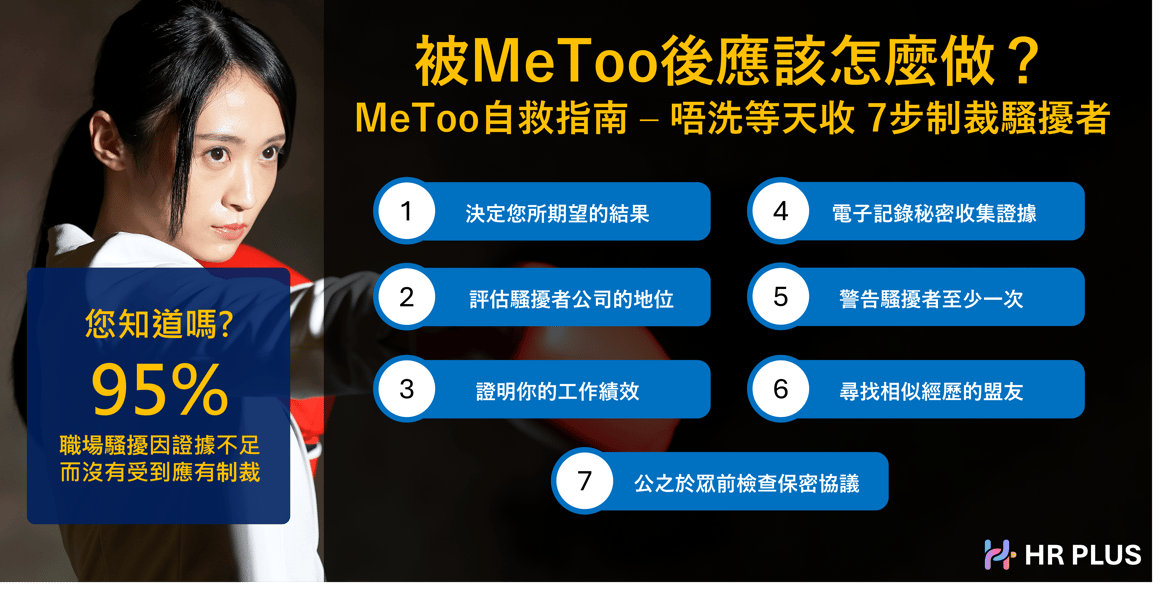[ 職場性騷擾] 被 MeToo 後應該怎麼做? MeToo 自救指南 – 唔洗等天收 ; 7步制裁騷擾者

COVID-19大流行過後,性騷擾問題在人們返回辦公室時逐漸增多。單在香港,平等機會委員會每年報告有300起性騷擾案例。在全球范圍內,約有30%的女性工作者在其職業生涯的某個時段曾經歷過不同形式的性騷擾。雖然#MeToo運動得到HR社群的積極支持,然而不幸的是,絕大部份(95%)的騷擾者依然逃脫了懲罰。這引起我們的疑問:#MeToo的受害者如何使加害者受到正義的制裁?
為什麼大多數騷擾者逍遥法外?
大多數騷擾者逃脫懲罰的原因是證據不足或疑點歸於被告。大多HR儘管同情受害者,但由於職責需要必須保持中立。HR需要明確的證據,排除其他合理懷疑 (如辦公室關係,績效不佳進行報復的情況),才可以採取制裁行動。那麼,受害者應如何協助HR將騷擾者繩之以法?
Step 1 : 決定您所期望的結果
受害者的第一個重要步驟是決定他們希望實現什麼目標。無論是讓騷擾者被解雇還是只是要求停止騷擾,明確的目標,將決定下一步行動的方向。
Step 2 : 評估騷擾者在公司中的地位
受害者的第二個關鍵步驟是評估騷擾者在公司中的地位,並確定向哪位上級報告此事。如果騷擾者擔任高級管理職務或是你的直接主管,最好是向高級HR領導提出投訴,他們在公司內有更大的影響力處理此事。但如果騷擾者是一名同事,您應該首先報告給你的直接主管。這一步骤對於確保你的投訴被提交給合適的公司權威,並有效阻止/制裁加害者的騷擾行為。
Step 3 : 用記錄來證明你的績效
受害者的第三個步驟是記錄自己的工作績效、以及任何可用的績效報告或文件。這些文件對於防止騷擾者虛偽指控你表現不佳並尋求報復至關重要。這有助於確保你在的案件有具體證據支持,保護你的職業聲譽。
Step 4 : 以書面和電子記錄秘密收集證據
受害者的第四個步驟是秘密收集證據。記錄每個事件的日期、時間和地點,發生了什麼以及有無目擊證人。保存相關的電子郵件、短信、照片或社交媒體帖子。事前準備好的人證物證可以防止加害者在調查中從中作梗,對於支持你的案件至關重要。
Step 5 : 至少需要警告騷擾者一次
受害者的第五個步驟是在事件發生時或之后明確警告騷擾者,並表示哪些行為讓你感到不舒服。研究表明,直面騷擾者可以有效制止騷擾。從法律角度來看,這一步驟也非常重要,因為它提供了你要求騷擾者停止行為的證據,並排除了將行為歸因于辦公室戀情的可能性。
Step 6 : 尋找有相似經歷的人
受害者的第六個步驟是尋找有相似經歷的人,並與可能在工作中受到騷擾的其他人建立聯繫。多於一人指控會大大增加指控可信性,使加害者難以開脫。
Step 7 : 在公之於眾之前檢查保密協議
如果內部流程失敗,而你希望公開你的案件,請先檢查你的工作合同是否包含因言入罪的保密或誹謗協議。如果存在此類協議,考慮匿名舉報或尋求平等機會委員會(EOC)的幫助。
通向正義之路
遵循這些步驟,你將大大提高成功的機會。謹記,受害者並不是無能為力,你的實際行動可以追究騷擾者的責任,令加害者受到正義的制裁,並為所有人創造一個更安全的工作環境。
___________________________________________________________________________________________________________________
What you should do after Metoo?
Metoo Saving Guide - 7 steps to justice
Sexual harassment has become more common as people return to their offices after the COVID-19 pandemic. In Hong Kong alone, the Equal Opportunity Commission reports 300 cases of sexual harassment each year. Globally, a survey reveals that about 30% of female workers have faced various forms of sexual harassment at some point in their careers. While the #MeToo movement and HR communities have shown strong support for preventing sexual harassment at workplaces, a shocking 95% of harassers escape punishment for their actions. This raises a critical question: How can victims of #MeToo bring justice to their harassers?
Why majority of harrsars goes unpunished?
The reason most harassers escape punishment at work is because HR, although empathetic towards victims, must maintain a neutral stance. To take action, HR needs clear evidence and must prove the harasser's guilt beyond a reasonable doubt. Often, harassers go unpunished due to insufficient evidence or because there's room for doubt, such as cases involving office relationships or concerns about retaliation for poor performance. So, how can we assist HR in bringing harassers to justice?
Step 1 : Decide what you want from the outcome
The first important step for a victim of sexual harassment is to decide what they want to achieve. Whether it's getting the harasser fired or just stopping the harassment, It's essential to have clarity about your goals as it sets the direction for your next steps in seeking justice and resolution.
Step 2 : Assess the harasser's position within the company
The second critical step for a victim of sexual harassment is to assess the harasser's position within the company and determine who to report the incident to. If the harasser holds a senior management position or is your direct supervisor, it's best to approach a senior HR leader who can address the matter impartially. However, if the harasser is a coworker, it's advisable to report the incident to your immediate supervisor. This step is essential in ensuring that your complaint is directed to the appropriate authority who can take the necessary action to address the issue effectively and fairly.
Step 3 : Justify your performance with records
The third step for a victim of sexual harassment is to maintain records of their job performance, productivity, and any available performance reports or files. This documentation is vital to prevent the harasser from falsely accusing you of poor performance and seeking retaliation. It helps ensure that your case against harassment is supported by concrete evidence, protecting your professional reputation.
Step 4 : Collecting Evidence in Secret: Using Written and Electronic Records
The fourth step for a victim of sexual harassment is to gather evidence discreetly. Document the date, time, and location of each incident, what happened, and any witnesses. Save emails, texts, photos, or social posts that are relevant. This evidence can be essential in supporting your case and seeking justice.
Step 5 : You need to warn the harasser at least once
The fifth step for a victim of sexual harassment is to issue a clear warning to the harasser, either when the incident occurs or at a later time. Be explicit about the behavior that makes you uncomfortable. Research indicates that directly confronting the harasser can help stop the harassment. This step is also crucial for legal purposes, as it provides evidence that you asked the harasser to stop and eliminates the possibility of attributing the behavior to an office romance.
Step 6 : Find another person with the same situation
The sixth step for a victim of sexual harassment is to find someone else with a similar experience and connect with others who may have been mistreated at work. Supporting each other and coming forward together can make it harder to dismiss the harasser's behavior, showing a pattern of misconduct.
Step 7 : Check NDA before Going Public
If internal processes fail and you wish to go public with your case, check your job contract for nondisclosure or nondisparagement clauses that could result in legal consequences for speaking out. These agreements are often used to silence victims. If such clauses exist, consider reporting anonymously or seeking assistance from the Equal Opportunities Commission (EOC).
Pathway to Justice
By following these steps, you can increase your chances of success. Remember that your voice is powerful, and these actions empower you to hold harassers accountable, contributing to a safer work environment for all. Your determination and resilience are key in shaping a brighter future where harassment is swiftly addressed and prevented.
